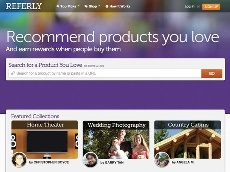The new word of mouth
The emergence of social commerce is taking word of mouth marketing to its next level by rewarding friends who go online to recommend products and services with cash, discounts and offers.

Brands have always known that consumers have the power of recommendation, but a new age of word of mouth is seeing a raft of fresh ways to encourage consumers to spread the message where they actually get paid to do so.
This new word of mouth marketing not only allows the consumer to take control of the brand message, it also lets people make commission from selling products.
Tesco, Debenhams, Pizza Hut and Iceland are among the high street retail brands encouraging people to share products and experiences, in return for some kind of reward. Last month, Tesco launched its Share & Earn scheme, where the brand’s Facebook fans earn Clubcard points for sharing products with their friends online.
“The advent of social media has resulted in increased numbers of customers openly discussing their opinions on specific products or retailers,” says Mark Entwistle, marketing director at Tesco.com.
“This should be viewed as a positive for a business that prides itself on putting the customer first. Share & Earn is a way of us saying ‘thank you’ to our brand advocates.”
Jewellery and accessories company Stella & Dot has taken the share and earn concept a step further by allowing brand advocates to sell its products to friends through websites that the new-style sales force set up themselves, in a ‘social commerce’ way (see Case Study, below).
Stella & Dot’s UK managing director Kathleen Mitchell says: “Even before social commerce, the power of word of mouth was always one of the marketing buzzwords that businesses strive for. Ecommerce changed the way people sold and social media is now playing a greater part. The arrival of Twitter, Pinterest and Facebook means word of mouth can go viral.”
The consumers who are selling products they like to their friends are called the ‘new brand champions’, according to a report by consultancy PSFK.

Its director of consulting Scott Lachut explains: “One of the things fuelling the shopper as an affiliate model is the rise of social media, which has amplified the voice of the consumer and empowered them.
“They are now able to reach out to brands in new ways, have conversations with them and interact with other shoppers in new ways, instantaneously.”
Sage, which creates software for business and is also responsible for processing a majority of the UK’s wages, has a programme where advocates help develop business ideas and technology.
Nicole Anderson-Mort, business development director at Sage, explains: “We have come into a great era where brand has moved from intangible to tangible and measurable as we go into the online and digital platforms.
“It is a time where a brand merges with the people that represent it. The businesses that get it are those that are open and connect with these consumers rather than being protective and separating themselves from potential customers.”
One step further
Online retailer Shopstyle goes one step further than the Sage model and allows people to create their own content. Its affiliate programme, Shopsense, is a free service that pays users for sending traffic to online retailers from their blog or website.
While this style of recommendation is just starting to take off on this side of the Atlantic, it is already established in the US, where many word-of-mouth sites and affiliate models of selling online have appeared this year (see Making Friends Across the Pond, below). For example, Referly – which launched in the US in April – allows users to earn rewards for recommending products to their networks.
People can profile and collect together brands and products they enjoy but without needing the time and skill it takes to build a website. “That’s the future of advertising,” says Kate Click, community manager at Referly. “The online catalogue is built around the natural brand conversations of passionate consumers. Except in this model, the consumers get commission for generating sales, not the advertising agencies.”
The nature of the social shopper is that they want to be the first person to tell their friends about a great deal or share something.
Peter Briffett, Living Social
Sometimes, people don’t need a big incentive to share their experiences with a brand. Iceland has found that consumers filling out online surveys will happily pass on their thoughts to friends. It uses an online tool called GoRecommend, developed by agency Empathica, to encourage people to fill out these surveys.
Iceland claims that through this, 2 million people have seen a branded message via social media. Steve Pennington, retail operations manager at the retailer, says: “There is no reward or incentive, but this might be something we might consider for the future.
“We have seen increased traffic on the Iceland website from the responsive impact of people seeing messaging online which generates conversations among friends. People believe what they read, especially on Facebook and Twitter, and comments are taken at face value.”
The development of digital technology and the rise in smartphone ownership have also ignited the use of brand champions and word of mouth from social shoppers.
Stylmee launched on the iPad in the US and allows users to create online 3D virtual stores within a ‘shopping city’ for which they receive rewards, offers and ‘Stylcash’ to use within the app (see Case Study, below). The difference here is that users compete with each other in weekly challenges, such as creating collections based on a theme, to show their fashion credentials.
Patrizia Favero, co-founder of Stylmee, says: “There aren’t a lot of entertaining options for the fashion consumer. Anytime you can add an entertainment layer to the shopping experience, you have the ability to prolong engagement and word of mouth.
“The longer the consumer is engaged, the deeper the connection created between the brand, its products and the consumer. Most importantly, this increases the potential of a purchase by recommending the product to their friends.”
The rise of the social shopper has not only spurred growth in recommendations in social media channels, it has also been interpreted literally by London-based start-up Lutebox which launched in June this year.
Exchange options
The company has created a website where friends and family can connect via the internet while they shop by giving each other opinions on clothes, sending pictures and showing each other products they need recommendations for. Users can also create their own stores to sell products to friends and family.
“Not a lot of players are addressing the social issues around shopping,” claims Ali Ahmed, founder of Lutebox, who believes that this new consumer affiliate model of selling has its negatives. “There is a flaw in incentivising consumers with rewards and commission to get the word out there. You may drive sales but at the same time it pushes users to spam their friends.”
Lachut at PSFK agrees. “There have been questions around whether giving a reward to people changes the nature of that transaction,” he says. “There is opportunity for people to abuse the system, but ultimately these communities police themselves. The people that are actually doing a good job of recommending products and adding value are going to rise to the top.”
But he points out that consumers are not that interested in the reward aspect of sharing products with friends online, they are more interested in their status in communities. “That is where the value will be, which links back to social currency and how many retweets or likes you get. It works in the same way.”
Click at Referly agrees that some people will take a get rich quick approach, but she says: “They’re actually not the successful ones. They will eventually be ignored and weeded out. The most successful referrals are those that are genuine about products owned and tested and arise in natural conversation.”
Living Social, which has been around for four years, uses a ‘me plus three’ scheme where the referee gets a product or offer free if three of their friends buy the same deal.
Peter Briffett, managing director of Living Social, points out that the deals have to be exciting enough to share. “The nature of the social shopper is that they want to be the first person to tell their friends about a great deal or share something.
“Brands want to engage with customers, they want customers talking about them, the web talking about them. But you have to promote the brand in the correct way, it has to be exciting enough for people to want to share that, and exciting enough to recommend.”
Brand promotion
Word of mouth has moved on from the simple message passed on when someone sees a friend face-to-face and recommends a new shop, service or product.
Yet it isn’t clear whether offering commission to consumers who act as affiliates will work or whether shoppers will naturally want to talk about great experience they have had with brands. But marketers now have the chance to appeal to people who can behave as friends with brand benefits.
The evolution of word of mouth
Word of mouth 1.0
Word of mouth used to revolve around the idea that one satisfied customer tell friends and family about the service they have received.
Word of mouth 2.0
Brands then capitalised on the potential of word of mouth marketing by developing strategies to actively gain brand advocates and set up affiliate models of selling, rather than simply using paid-for advertising. The rise of online shopping, comparison and review sites, social media, and experiential marketing all helped the spread of word of mouth.
Word of mouth 3.0
More recently, brands have started to put their business in the hands of the consumer. Affiliate selling has moved from agencies pushing out links to drive sales to consumers becoming the curators of their own websites. They recommend and share products on a variety of platforms, whether that is through virtual stores, apps or online store fronts, and earn rewards, points and cash.
Making friends across the pond
The affiliate model of selling is moving from companies creating traffic and sales for brands to actual consumers creating their own web pages and platforms to recommend products to their network - and being rewarded with cash or discounts. This new way of selling has been adopted in the US by the following sites.
Mulu.me
This site enables users to curate their own content via their websites and provide links to clothes or other products. Any purchase that someone else makes earns the curator a cut of the revenue. Celebrity users include actress Zooey Deschanel, socialite and model Ivanka Trump and burlesque dancer Dita Von Teese.
Mark.
This online beauty and fashion boutique offers its customers the chance to promote, market and sell its products both online and offline in return for discounts, promotions and commission for the sales generated by their brand advocacy. Customers can set up their own online eBoutique and sell via brand-sponsored parties.
Wikets
This app lets people recommend products from featured partners and retailers, including iTunes, eBay, Amazon and The Home Depot, link to places via Yelp or Foursquare and scan a product’s barcode. Recommendations are then shared within the app with the users’ followers, who can also follow other users to see the products and places they like and can re-recommend, comment or buy the product from within the app itself. Users get points for recommendations, in-app activity and purchases, which can be redeemed for gift cards from selected retailers.

Referly
This online community allows people to earn cash, discounts and other rewards for their recommendations by tracking links that are shared. Users can keep, share or donate their cash commission to charity.
Case study: Stella & Dot
Boutique jewellery brand Stella & Dot is taking the direct selling model head first into the digital age, going beyond the Tupperware-style home parties that this kind of business is known for.
While throwing parties - or trunk shows as it calls them – at the homes of friends, acquaintances and family members is a core way that its ‘stylists’ promote and sell products, the company gives sellers access to their own personalised social commerce platform, where products can be purchased around the clock. Stylists can promote their site via Facebook, Twitter and Pinterest.
US entrepreneur and mother of two Jessica Herrin wanted to create a digital direct selling business that would appeal to other mums and women who wanted to run a company that fitted around their lives. Herrin felt that giving stylists social media tools was key to bringing direct selling into the 21st century.
Stella & Dot launched in the UK in 2011, hoping to emulate its success in the US and Canada where it employs 11,000 sales people, who earn up to 30 per cent commission on sales.
There are already 1,000 stylists in the UK with plans to recruit a further 1,000 by the end of 2012, who pay Stella & Dot £198 to receive a starter kit which includes jewellery samples and marketing materials. According to the company, UK sales are on track to exceed £7m in 2012, with plans to launch in Germany soon.
Kathleen Mitchell, UK managing director of Stella & Dot, believes that its social commerce platform is key to recruiting stylists and expanding the business. She adds that this type of model puts the business in the hands of the consumers, who then become the seller. The idea being that consumers are more likely to buy via recommendation and word of mouth from someone they know, rather than direct from the brand.
“For us it’s essential to have these third-party advocates for our selling model,” she says. “We have independent stylists who run their own business, but they sell through ecommerce platforms, so we don’t rely on the high street.
Mitchell adds: “If you don’t involve the consumer and create a truly social enterprise, your business will be on one side and your customers on another because everyone is engaging in this way.”
Case Study: Stylmee

Stylmee is a social shopping app and game that allows users to set up virtual boutiques. They earn rewards and points when other members ‘love’ their boutique design or styles. The more points that a boutique ‘owner’ earns, the more access they have to special and exclusive offers from Stylmee’s partner brands.
So the idea is a mixture of entertainment – in the form of gaming – shopping and making money. Co-founder Patrizia Favero says people want to find new ways of having fun online. “It is becoming very difficult to keep the consumer engaged,” she claims.
The Stylmee app uses real products as part of a gaming experience where players navigate a virtual 3D city where they can view, shop and share brands. Participants open, design and create collections online, which are presented as virtual boutiques and appear in the Stylmee City.
The objective is to select the best styles from featured brand collections, based on a weekly style challenge.
Players gain points when peers vote on their boutique or products. These points can be redeemed for retail incentives and ‘Stylcash’, which can be used to buy products within the app.
Favero adds: “Stylmee has only been going for 12 weeks, but it has already received a positive response. The site has been featured on iTunes and we have had enquiries from small retailers and brands to participate. Women aged 25 to 44 are the most active users of social gaming, which is the same as the target market for Stylmee.”
The social shopping app is an example of companies, particularly in the US, that are engaging consumers in a way that encourages word of mouth and friend recommendation for brands and their products.
Favero says: “Women are especially conscious of recommendations given to them by their peers, friends and colleagues. Considering that fashion and shopping are a form of entertainment that women prefer, there is a natural fit for recommendation through a ‘gamified’ experience.”









